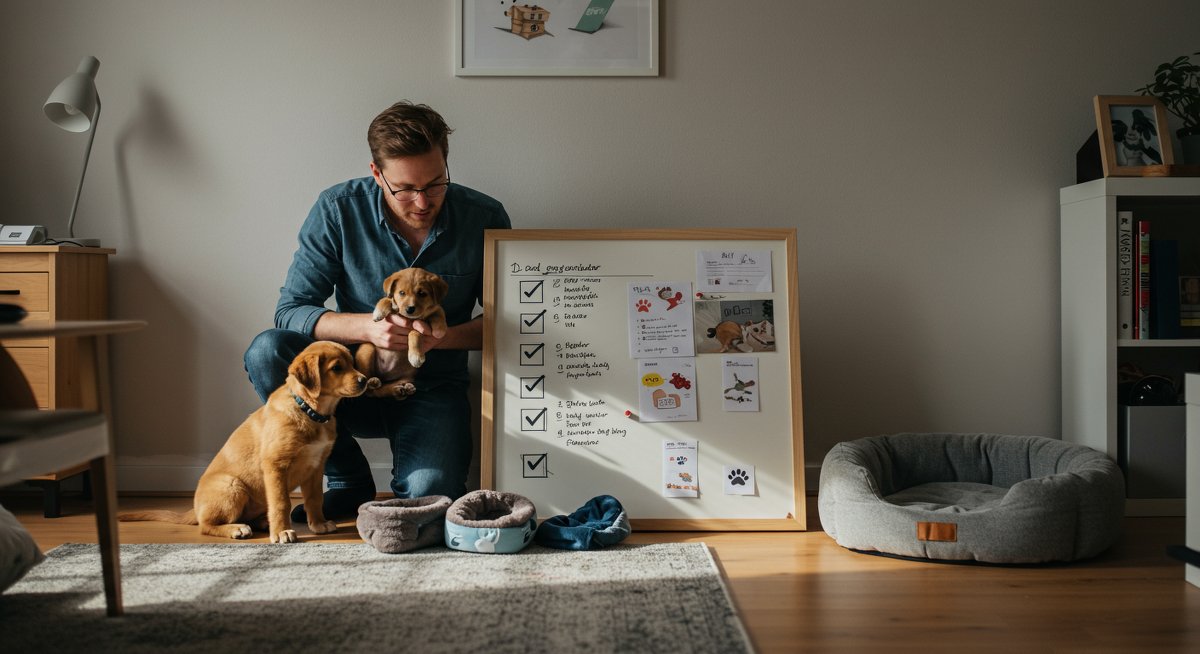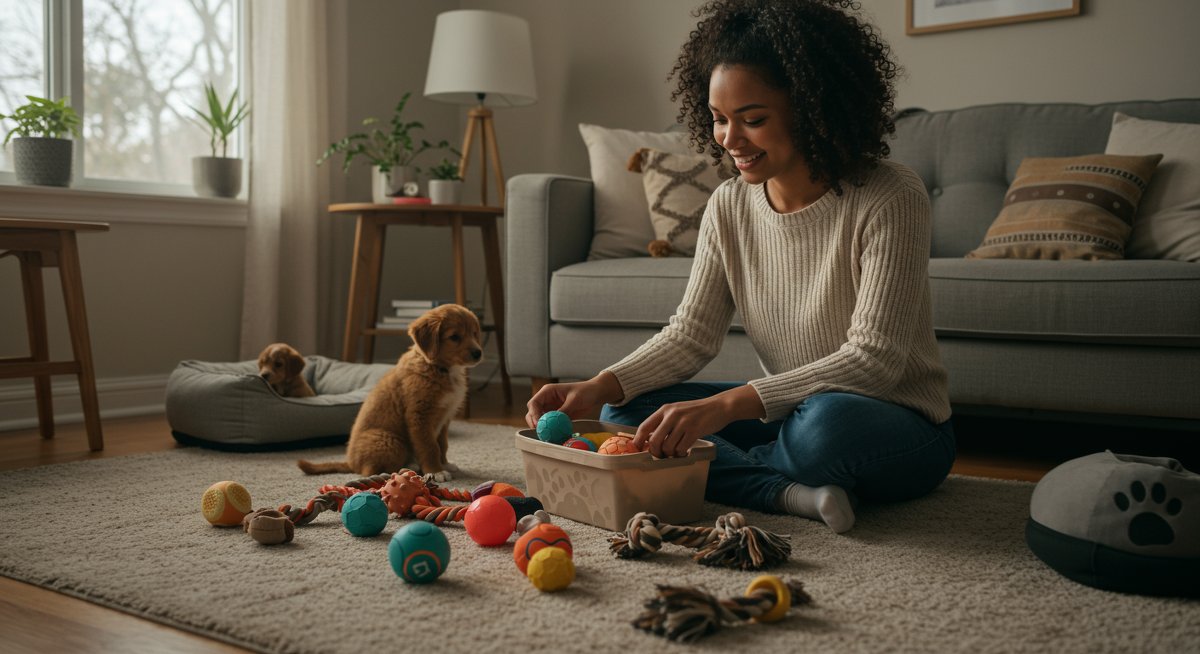Bringing a new puppy home is an incredibly exciting time! It’s also a time of significant change and a little bit of preparation. As a new pet owner, you're embarking on a rewarding journey, and having the right supplies and a solid plan will make the transition smoother for both you and your furry friend. This guide serves as your new puppy checklist, providing a comprehensive list of essential items, from food and bowls to toys and training tools, plus helpful tips for those crucial first weeks. We’re here to support you every step of the way!

Why Understanding a Puppy Checklist is Crucial for Your New Pet
Preparing for your new puppy is like preparing for a baby: You want to create a safe, comfortable, and stimulating environment. A puppy checklist is more than just a shopping list; it’s a roadmap to responsible pet ownership. Having essential supplies ready before your puppy arrives ensures a stress-free welcome. It also helps you establish a routine, which is incredibly important for a young dog. Puppies thrive on consistency. A well-prepared home reduces anxiety for your puppy and helps you focus on bonding and training. Failing to prepare can lead to last-minute scrambling, potential safety hazards, and an overwhelming experience for your new family member.
Consider the story of Sarah, a first-time puppy owner who didn't have a puppy checklist. When she brought her Golden Retriever puppy, Max, home, she realized she didn't have a crate or puppy-safe cleaning supplies. This meant a frantic trip to the pet store and a delay in establishing a safe sleeping space for Max. Having a checklist ensures you can avoid these common pitfalls and focus on the joy of welcoming your puppy.
Essential First Steps for Puppy Care
Before your puppy arrives, there are a few essential first steps to take to ensure a smooth transition. First, puppy-proof your home! Remove any hazards like electrical cords, toxic plants, and small objects that could be swallowed. Next, schedule a vet appointment within the first week. Your vet will give your puppy a checkup, administer necessary vaccinations, and provide valuable advice. Begin researching local puppy training classes or at-home training methods. Early socialization is critical, so expose your puppy to new sights, sounds, and people in a controlled and positive way. Finally, gather all the essential supplies from your puppy checklist.
One of the most critical early steps is to establish a feeding schedule. Puppies need to eat multiple times a day to support their rapid growth. Following a consistent feeding routine not only helps with their physical development but also aids in house training. A sample schedule for an 8-week-old puppy could be: Breakfast at 7 AM, Lunch at 12 PM, Dinner at 5 PM, and a small bedtime snack. This also helps regulate their bathroom breaks!
Common Challenges & How to Overcome Them
Bringing a puppy home isn't always easy. One of the most common challenges is house training. Accidents will happen, but consistency is key. Take your puppy outside frequently, especially after waking up, eating, and playing. Reward successful potty breaks with praise and a treat. Crate training can also be an invaluable tool. A crate provides a safe den for your puppy and aids in house training. Another common challenge is puppy biting. Puppies explore the world with their mouths. Provide plenty of appropriate chew toys to redirect biting behavior. Socialization is also critical. Introduce your puppy to various people, places, and situations to help them grow into a well-adjusted dog.
Consider the story of Mark, who struggled with house training his new Labrador puppy. He wasn't taking his puppy outside frequently enough and wasn’t using positive reinforcement. After consulting a professional trainer and adjusting his routine, Mark began taking his puppy outside every two hours and rewarding every successful potty break with a small treat. Within a week, his puppy’s accidents significantly decreased.
Tips for Success (e.g., basic training, feeding schedules)
Successful puppy ownership involves a combination of consistency, patience, and positive reinforcement. Basic training is essential. Start with commands like “sit,” “stay,” and “come.” Use positive reinforcement, such as treats and praise, to reward desired behaviors. Short, frequent training sessions are more effective than long ones. Feeding schedules are also vital. Puppies require a high-quality puppy food formulated for their age and breed. Divide their daily food allowance into several meals. Always provide fresh water, and consider using a slow-feeder bowl to prevent gulping. Socialization is a continuous process. Introduce your puppy to new experiences, people, and dogs in a safe and controlled environment.
For instance, when teaching the “sit” command, hold a treat near your puppy's nose and move it over their head. As their nose follows the treat, their rear end should naturally lower into a sit. The moment their bottom touches the ground, say “sit” and give them the treat and praise. Repeat this several times a day, and your puppy will quickly learn the command. Remember to keep training sessions short and fun!
Building a Strong Bond with Your Puppy
Building a strong bond with your puppy is one of the most rewarding aspects of pet ownership. Spend quality time with your puppy every day. Play games, go for walks, and simply cuddle. Positive interactions build trust and strengthen your connection. Engage in interactive play. Toys like Kong Toy can provide mental stimulation and prevent boredom. Regular grooming sessions, even if it’s just brushing their fur, can also strengthen your bond. Praise and reward your puppy often. Celebrate their successes and offer reassurance when they're feeling anxious. A well-bonded puppy is more likely to be well-behaved and happy.
Consider the example of Emily and her new Goldendoodle puppy, Finn. Emily made it a point to spend 15-20 minutes each day playing fetch in the backyard. This simple activity became a daily ritual. Emily also made sure to hand-feed Finn his meals, which helped build trust and positive associations. These small actions fostered a deep connection between them.

Recommended Products for New Owners
Having the right products on hand will set you and your puppy up for success. Here’s a list of recommended items:
- Food and Water Bowls: Choose sturdy, non-tip bowls made of stainless steel or ceramic.
- High-Quality Puppy Food: Select a puppy-specific formula that meets the nutritional needs of your puppy’s breed and age. Consider Hill's Science Diet for a well-balanced option.
- Crate: Select a crate that is appropriately sized for your puppy to stand up, turn around, and lie down comfortably.
- Bed: A comfortable bed for your puppy to sleep in. Consider a washable bed for easy cleaning.
- Collar and Leash: Choose a lightweight collar and a 4-6 foot leash. Make sure the collar fits properly.
- Identification Tags: Include your puppy's name, your contact information, and any relevant medical information.
- Toys: Provide a variety of toys, including chew toys, soft toys, and interactive toys.
- Training Treats: Use small, tasty treats for training purposes. Look for low-calorie options.
- Grooming Supplies: A brush suitable for your puppy's coat type.
- Puppy Pads: Puppy pads for house training accidents.
- Pet-Safe Cleaning Supplies: To clean up any messes and eliminate odors.
Quick Troubleshooting Guide
Even with the best preparation, challenges can arise. Here's a quick troubleshooting guide for common issues:
- Excessive Biting: Redirect biting with appropriate chew toys. If biting persists, consult a professional trainer.
- House Training Accidents: Increase the frequency of potty breaks, and ensure consistent positive reinforcement. If accidents persist, consult your vet to rule out any medical issues.
- Destructive Chewing: Provide plenty of chew toys and puppy-proof your home. Consider a crate or a designated safe space.
- Whining or Crying at Night: Ensure your puppy has a comfortable and safe sleeping space. Consider a calming aid, like a heartbeat toy, and be patient.
- Separation Anxiety: Gradually increase the time you spend away from your puppy, and provide plenty of mental stimulation. Consider consulting a professional trainer.
Next Steps in Your Pet Parenthood Journey
Bringing home a puppy is just the beginning of a wonderful adventure. Once you've established your home and your puppy has settled in, consider enrolling in obedience classes or continuing training at home. Continue socializing your puppy. Stay consistent with training, feeding, and exercise. Enjoy the journey! Remember, every puppy is unique. Be patient, celebrate the small victories, and cherish the bond you're building with your new companion. Enjoy the journey, and don't be afraid to ask for help. Local vets are a great resource, as are professional trainers.